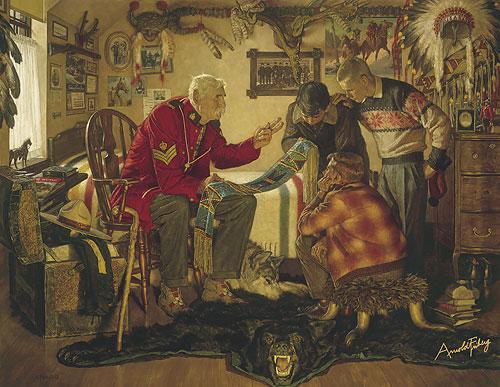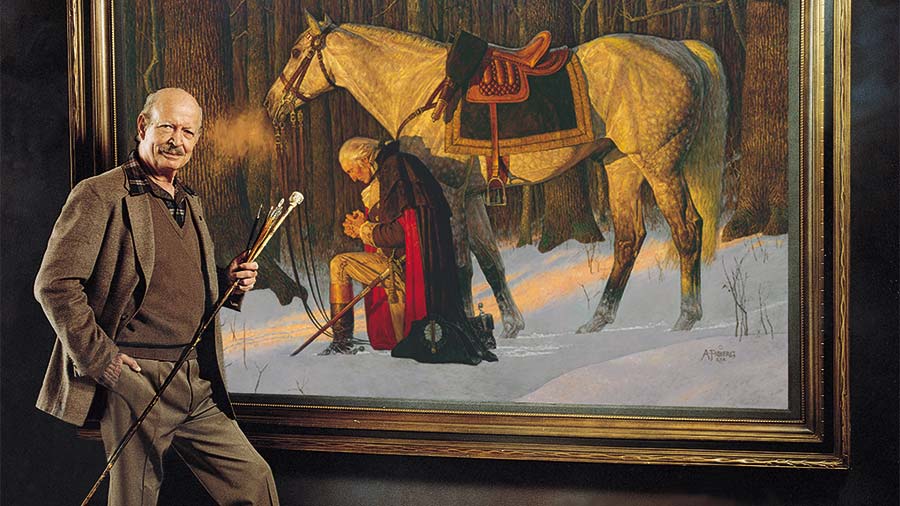Listen to Arnold Friberg Talk On The Prayer At Valley Forge
ARNOLD FRIBERG
1913 - 2010
Arnold Friberg SignatureArnold Friberg, the son of Scandinavian immigrants, was born on December 21, 1913, in Winnetka Illinois, a suburb of Chicago. At the age of 3, Arnold moved to Arizona with his sister, Gertrude, and his parents. By age 7 young Friberg was already drawing original cartoons. Mr. Friberg remembers, "I never had to take an aptitude test, I always knew what I wanted to do, Art".
The Friberg's were able to scrape together enough money to enroll Arnold in a correspondence course at the age of 10. While in Phoenix Arizona, young Friberg often shared his drawings with the newspaper staff of the Arizona Republican and he learned from them. During his high school years, Arnold earned money by making signs for local businesses. After graduating from high school, he began his studies at the Chicago Academy of Fine Arts.
While attending the Academy, Arnold worked part-time for printers. Arnold stayed in the Chicago area for several years and worked in the commercial art field. It was during this time that he became acquainted with the Northwest Paper Company and their ad campaign featuring the Canadian Mounties. Little did he know the importance this would play in his future. In 1940, Arnold moved to New York City into the publishing world of Manhattan. While there, he enrolled in night classes at the Grand Central School of Art, where he studied with Norman Rockwell under Harvey Dunn, one of the countries top illustrators.
In 1948 Arnold accepted a commission to do scenes of the American West for a calendar series by the Louis F. Dow Calendar Company. This would become the start of his serious interest in the West. By 1950 Arnold and his wife had moved to Utah, and Arnold started teaching commercial art at the University of Utah. During his teaching, a great producer and director Cecil B. DeMille was planning his immense production of "The Ten Commandments". DeMille was in need of an artist with both "the rare talent and inner vision to set down in the paint, all of the power, the color, the human drama." After a long search, which included Europe, a publisher friend in Sweden sent DeMille prints of Arnold's scriptural illustrations. Demille knew he had found his artist.
This led to Friberg's move to Hollywood in 1953. There, Arnold worked with Cecil B. DeMille for over three years on the epic motion picture "The Ten Commandments" as his chief artist and designer. Arnold worked closely with DeMille to visualize, through hundreds of sketches and paintings, a variety of scenes and human characters for the motion picture. Arnold Friberg's 15 paintings for "The Ten Commandments" became the pictorial basis for the movie's scenes, characters, and costumes, which earned him an Academy Award Nomination.
The paintings, when unveiled, toured the world, allowing millions to view them. Cecil B. DeMille estimated that "when 'The Ten Commandment' paintings toured the world, they were seen by more people than any other paintings except for some of the most celebrated masterpieces such as the 'Mona Lisa', 'Nightingale', and 'The Last Supper'." DeMille also stated that "Among the living artists who have dedicated their talents largely to religious art, Arnold Friberg stands out for his virility and warmth, dramatic understanding and truth. He has accomplished a strong and real service in bringing the truth of the Bible to a wider understanding, appreciation, and acceptance." In the field of traditional realistic paintings, Arnold Friberg stands alone as the greatest living interpreter of Scriptural subjects.
In 1968 the Chevrolet Motor Company, a division of General Motors, commissioned Mr. Friberg to do a series of paintings depicting the most famous games in the history of American intercollegiate football. These paintings were used during the 1969 advertising campaign and were among the most demanding and exciting pieces Mr. Friberg had done. His extensive research included visiting the Notre Dame Stadium and locker room where Knute Rockne had coached. These paintings were such a success that they were taken on tour and shown at universities throughout the country.
Mr. Friberg also has great respect for the Native American culture and a reverence for the land and people of the early west, which is apparent in his work. Some of his most fascinating scenes are those in his "Saloon" paintings, the first of which he did in 1977 for Steven A. Wynn, the owner of the Golden Nugget Casino in Las Vegas. Before undertaking that painting, Mr. Friberg did extensive research. He studied old glass - negative photos of old-time saloons, visited old saloons, and investigated the type of people who frequented them. He realized that rather than being 'Dens of Iniquity', saloons were merely social gathering spots, and he painted them as such, using great detail in his portrayal. He even recreated actual authentic paintings found on the walls in those old saloons.
"I photographed those pictures in old saloons and museums", said Mr. Friberg, "then I put the final picture together like I was designing a movie set in order to make as complete a statement of an old western saloon as possible. "And", said Friberg, "I like to give people a lot to look at so they don't tire of looking at it." Throughout his career, Mr. Friberg has painted a variety of themes: railroads and wagon trains, mountain men and miners, Indians and religious figures, the U.S. Calvary and the Royal Canadian Mounted Police, canoes, and sailing ships, wildlife, and horses. But, if he is to be known for anything, he hopes it is the horse. Mr. Friberg prides himself in the detail he uses, especially the detail he uses in his paintings of horses.
One of his largest and favorite pieces, painted in 1975, is of George Washington kneeling in prayer beside his horse at Valley Forge. Originally painted to honor our country's Bi-centennial year, "The Prayer at Valley Forge" in the past 20 years has become increasingly cherished and recognized as a supreme 20th-century masterpiece of patriotic American art. In it we feel the cold, the suffering, and the weight of the burden falling on that tall and lonely man, driven to his knees there in the bitter snows of Valley Forge. This picture, marking a bold rejection of fleeting artistic and political 'fashions', now expresses a powerful affirmation of faith, patriotic duty, and the deep spiritual depths in the founding of our country.
To prepare for this painting, to ensure accuracy in trees and landscape, Mr. Friberg made a pilgrimage to Valley Forge, in the dead of winter. "In the summer the place is filled with visitors", said Mr. Friberg, "but now, in the snows of February, it was deserted, the wind moaning through the great trees, silent, lonely, cold. It was a cold that chilled to the bone. A cold that froze my fingers until I could no longer sketch or even snap my camera. To ensure accuracy in man-made things, I sought out whatever museums, collections, libraries, or informed individuals who could offer details on horse gear or uniform. At the Smithsonian Military History Museum, I made minutely accurate sketches from the very uniform actually worn by Washington.
As for facial likeness, I studied every portrait ever sketched, carved, or painted from life, but always keeping in mind how cold and rawboned he must have looked during that winter encampment. But such research, vital as it is, provides only physical facts. What I really tried for, through the medium of paint, was to recall the pain and the cold of that cruel winter of 1777-78. I sought to pay tribute to the tall and heavy-burdened man who held our struggling nation together."
Arnold Friberg learned to paint horses when he began painting the Royal Canadian Mounted Police in the late 1930s for the Northwest Paper Company Calendars. To date, he has done almost 300 Mountie paintings, which has earned him a special place among his subjects. He is the only American who has ever been made an honorary member of the Royal Canadian Mounted Police. In 1978 as a result of his work with the Mounties, he was commissioned to do an almost life-size portrait of H.R.H. Prince Charles with his great horse "Centennial", the great-grandson of Man-O-War. This was done at a studio in the Buckingham Palace.
Then in 1990, Mr. Friberg and his wife were invited back to spend another six weeks residing in the Buckingham Palace in diligent preparatory sittings and studies for his commissioned undertaking of a splendid equestrian portrait of Queen Elizabeth II and Centennial. Being commissioned to paint these royal portraits would mean that Mr. Friberg's name would be included in a list with such great artists as; Rembrandt, Velazquez, Raphael, Rubens, Van Dyck, and numerous other masters who had painted portraits of the Royal family. Mr. Friberg described himself as a storyteller. "That's all I've ever wanted to do, that's why I went into illustrating." Mr. Friberg passed away in July 2010 in Salt Lake City. "Art to me is a service, to bring enrichment to people's lives. That's why I want my art to be perfectly understood. One of the things I work for is clarity. That doesn't mean hard-edged forms, but the clarity of the picture: what time of day, what kind of lighting, where it is."
In recognition of his spiritual, royal, and other historical paintings, Arnold Friberg was made a life member of the ancient and honorable Royal Society of Arts, London, which accounts for the initials R.S.A. after his name. And while his paintings are realistic and historically correct, it is Mr. Friberg's extraordinary ability to capture not only the drama of history but also the vibrancy and inner strength of human characteristics that have earned him the respect and recognition as one of the greatest master painters of modern times.
“All you leave the world is what you’ve done. No one will ever know the conditions, the comments, the pressures. Only the work remains.” – Arnold Friberg
